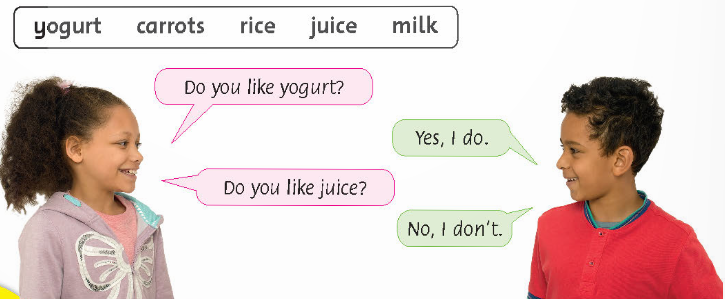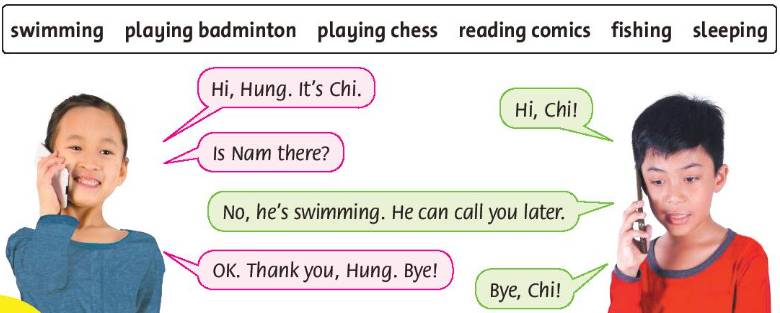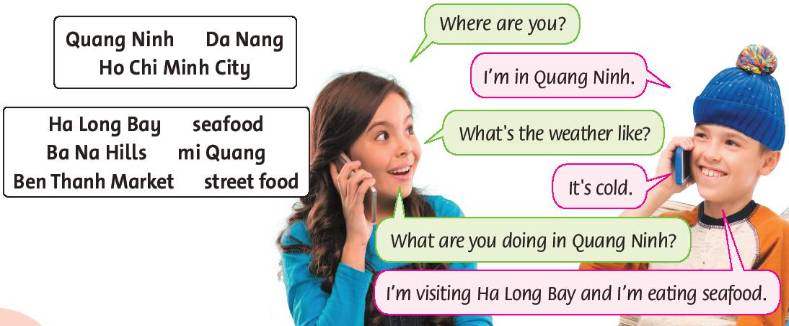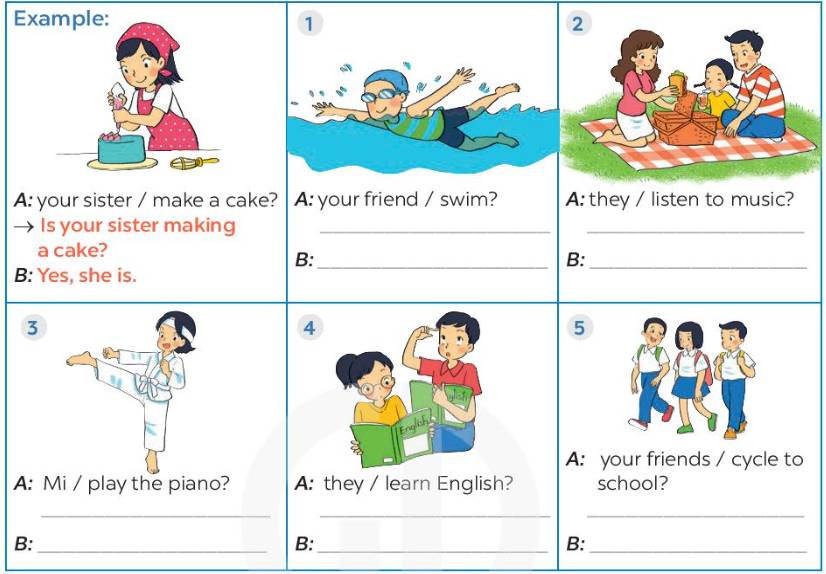Look at the food words. Ask and answer.

Look at the words. Ask and answer.

1.
Hi, Hung. It’s Chi. (Chào Hùng. Đó là Chi.)
Hi, Chi! (Chào Chi!)
Is Nam there? (Nam có ở đó không?)
No, he’s playing badminton. He can call you later. (Không, anh ấy đang chơi cầu lông. Anh ấy có thể gọi cho bạn sau.)
Oh. Thank you, Hung. Bye! (Ồ. Cảm ơn Hùng. Tạm biệt!)
Bye, Chi! (Tạm biệt, Chi!)
2.
Hi, Hung. It’s Chi. (Chào Hùng. Đó là Chi.)
Hi, Chi! (Chào Chi!)
Is Nam there? (Nam có ở đó không?)
Yes, he’s fishing. He can call you later. (Có. Anh ấy đang câu cá. Anh ấy có thể gọi cho bạn sau.)
Oh. Thank you, Hung. Bye! (Ồ. Cảm ơn Hùng. Tạm biệt!)
Bye, Chi! (Tạm biệt, Chi!)
Look at the words. Ask and answer.

1. Where are you? (Bạn đang ở đâu vậy?)
I’m in Da Nang. (Tôi ở Đà Nẵng.)
What's the weather like? (Thời tiết ở đấy như thế nào?)
It's sunny. (Trời nắng.)
What are you doing in Da Nang ? (Bạn đang làm gì ở Đà Nẵng?)
I'm visiting Ba Na hills and I'm eating mi quang. (Tôi đang tham quan Bà Nà Hills và tôi đang ăn mì quảng.)
2. Where are you? (Bạn đang ở đâu vậy?)
I’m in Ho Chi Minh city. (Tôi ở thành phố Hồ Chí Minh.)
What's the weather like? (Thời tiết ở đấy như thế nào?)
It's sunny. (Trời nắng.)
What are you doing in Ho Chi Minh city ? (Bạn đang làm gì ở thành phố Hồ Chí Minh?)
I'm visiting Ben Thanh market and I'm eating street foods. (Tôi đang ghé thăm chợ Bến Thành và tôi đang ăn thức ăn đường phố.)
Look at the words in the box. Ask and answer.

- What are you doing? (Bạn đang làm gì vậy?)
We’re snorkeling. (Chúng tôi đang lặn.)
- What are you doing? (Bạn đang làm gì vậy?)
We’re swimming. (Chúng tôi đang bơi.)
- What are you doing? (Bạn đang làm gì vậy?)
We’re eating seafood. (Chúng tôi đang ăn đồ hải sản.)
Look at the pictures. Ask and answer.


- Is the monkey eating in Picture C? (Có phải con khỉ trong tranh C đang ăn không?)
No, it isn’t. (Không phải.)
- What’s it doing? (Nó đang làm gì vậy?)
It’s climbing. (Nó đang trèo.)
- Is the tiger sleeping in picture A? (Có phải con hổ ở tranh A đang ngủ không?)
Yes, it is. (Đúng vậy.)
-Ask and answer about the temple of literature.
-Ask and answer about your health. -Ask and answer about community service. -Ask and answer about food and drink.1. Look at the photos in School food. Choose the correct words in the texts. Listen and check your answer.
(Nhìn vào các bức ảnh trong phần Đồ ăn ở trường học. Chọn từ đúng trong bài khóa. Hãy nghe và kiểm tra lại câu trả lời của em.)
SCHOOL FOOD
This is what people are saying about their school lunches around the world. Which ones do you like best?
SOUTH AFRICA: I'm making a (1) sandwich / burger for my lunchbox. I've also got an (2) apple / egg and some (3) water/juice.
INDIA: It's normal to eat with your hands here. We're vegetarians, so there isn't any (4) fruit/meat with our (5) pasta/rice.
THE UK: I have pizza and (6) chips / rice today with (7) pasta/beans. There are (8) eggs /vegetables, but I don't like them.
VIỆT NAM: We often have (9) rice / bread with meat and vegetables for lunch at school. We really enjoy our time eating together.
THE USA: Vending machines in schools here don't sell crisps and (10) sweets/chips now. They've got healthy snacks like (11) nuts / crisps and they sell juice, not (12) water / fizzy drinks.
ARGENTINA: Our school lunches are quite healthy. Today we have meat with (13) chips/egg. My favourite!
AUSTRALIA: I'm having fish and chips with some (14) salad/pasta and (15) bread / cheese. Tasty!
SPAIN: I really like the menu today – (16) rice / pasta, (17) chicken / pizza pieces and salad, yoghurt,
bread and (18) juice / water.
JAPAN: Students here help to serve the food and we clean the tables! Today we're serving (19) soup / juice.
1. sanwich
2. apple
3. juice
4. meat
5. rice
6. chips
7. beans
8. vegetables
9. rice
10. sweets
11. nuts
12. fizzy drinks
13. egg
14. salad
15. bread
16. pasta
17 chicken
18 water
19. soup
SCHOOL FOOD
This is what people are saying about their school lunches around the world. Which ones do you like best?
SOUTH AFRICA: I'm making a (1) sandwich for my lunchbox. I've also got an (2) apple and some (3) juice.
INDIA: It's normal to eat with your hands here. We're vegetarians, so there isn't any (4) meat with our (5) rice.
THE UK: I have pizza and (6) chips today with (7) beans. There are (8) vegetables, but I don't like them.
VIỆT NAM: We often have (9) rice with meat and vegetables for lunch at school. We really enjoy our time eating together.
THE USA: Vending machines in schools here don't sell crisps and (10) sweets now. They've got healthy snacks like (11) nuts and they sell juice, not (12) fizzy drinks.
ARGENTINA: Our school lunches are quite healthy. Today we have meat with (13) egg. My favourite!
AUSTRALIA: I'm having fish and chips with some (14) salad and (15) bread. Tasty!
SPAIN: I really like the menu today – (16) pasta, (17) chicken pieces and salad, yoghurt,
bread and (18) water.
JAPAN: Students here help to serve the food and we clean the tables! Today we're serving (19) soup.
Tạm dịch:
THỨC ĂN Ở TRƯỜNG
Đây là những gì mọi người đang nói về bữa ăn trưa ở trường học của họ trên khắp thế giới. Bạn thích món nào nhất?
NAM PHI: Tôi đang làm bánh sandwich cho hộp cơm trưa của mình. Tôi cũng có một quả táo và một ít nước trái cây.
ẤN ĐỘ: Ở đây ăn bằng tay là chuyện bình thường. Chúng tôi là những người ăn chay, vì vậy không có thịt để ăn với cơm của chúng tôi.
ANH: Hôm nay tôi có pizza và khoai tây chiên với đậu. Có một ít rau, nhưng tôi không thích chúng.
VIỆT NAM: Chúng tôi thường có cơm với thịt và rau cho bữa trưa ở trường. Chúng tôi thực sự thích thời gian ăn uống cùng nhau.
HOA KỲ: Máy bán hàng tự động ở các trường học ở đây hiện không bán khoai tây chiên giòn và bánh kẹo. Chúng có bán đồ ăn nhẹ lành mạnh như các loại hạt và họ bán nước trái cây, không phải thức uống có ga.
ARGENTINA: Bữa trưa ở trường của chúng tôi khá lành mạnh. Hôm nay chúng ta có thịt với trứng. Món yêu thích của tôi!
ÚC: Tôi đang ăn cá và khoai tây chiên với một ít salad và bánh mì. Ngon lắm!
TÂY BAN NHA: Tôi thực sự thích thực đơn hôm nay - mì ống, miếng gà và salad, sữa chua, bánh mì và nước.
NHẬT BẢN: Học sinh ở đây giúp phục vụ đồ ăn và chúng tôi dọn bàn! Hôm nay chúng tôi đang phục vụ súp.
(ĐOÁN TÊN MÓN ĂN. Làm việc theo cặp. Nhìn vào các từ trong khung Một học sinh chọn một từ và đặt một câu về từ đó. Học sinh còn lại lắng nghe và đoán tên món ăn.)
burger pasta raisins meat juice sweets rice vegetables nuts crisps cheese pear olives tuna |
It's got bread and meat. It's unhealthy.
(Nó có bành mì và thịt. Nó không lành mạnh lắm.)
Burger?
(Bánh burger à?)
1.
A: It looks like noodles but it is bigger than noodles.
(Trông giống như sợi mì nhưng nó to hơn sợi mì.)
B: Pasta? (Mỳ ống à?)
2.
A: It’s the dried grapes.
(Đó là nho được làm khô.)
B: Raisin? (Nho khô?)
3.
A: It’s a liquid and it’s really good for our health?
(Nó là một chất lỏng và nó thực sự tốt cho sức khỏe của chúng ta?)
B: Juice? (Nước trái cây à?)
4.
A: Children like them. They can cause toothache.
(Trẻ em thích chúng. Chúng có thể gây đau răng.)
B: Sweets? (Kẹo à?)
5.
A: Vietnamese people eat it every day?
(Người Việt Nam ăn nó hàng ngày.)
B: Rice? (Cơm à?)
6.
A: It’s green and it’s really good for our health?
(Nó có màu xanh và nó thực sự tốt cho sức khỏe của chúng ta?)
B: Vegetables? (Rau à?)
7.
A: It’s hard and it’s inside the fruits.
(Nó cứng và nó ở bên trong quả.)
B: Nuts? (Hạt à?)
8.
A: They are made of potatoes.
(Chúng được làm bằng khoai tây.)
B: Crips? (Khoai tây chiên giòn?)
9.
A: The mice like it. (Những con chuột thích nó.)
B: Cheese? (Phô mai à?)
10.
A: It is a kind of fruit. It’s small on the top and big at the bottom.
(Đó là một loại trái cây. Nó nhỏ ở trên và lớn ở dưới.)
B: Pear? (Quả lê hả?)
11.
A: People often make oil from these fruits. It’s really good for small children.
(Người ta thường làm dầu từ những loại quả này. Nó thực sự tốt cho trẻ nhỏ.)
B: Olives? (Ô liu à?)
12.
A: It’s a big fish that lives in the sea. (Đó là một loài cá lớn sống ở biển.)
B: Tuna? (Cá ngừ à?)
Find the differences. Student A: Look at the picture below. Student B: Look at the picture on page 136. Ask and answer the questions about the pictures

Difference in two pictures
Picture in page 95 | Picture in page 136 |
- Maria and Anna are talking - Nathan and David are using computer - Julie is talking con the phone - Manuela is playing tablet | - Manuela and Julie are talking - Nathan and Anna are using computer - David is talking on the phone - Maria is playing tablet |
Hướng dẫn dịch
Sự khác nhau giữa hai bức tranh
Bức tranh ở tranh 95 | Bức tranh ở tranh 136 |
- Maria và Anna đang nói chuyện với nhau - Nathan và David đang sử dụng máy tính -Julie đang nói chuyện điện thoại - Manuela đang chơi máy tính bảng | - Manuela and Julie đang nói chuyện với nhau - Nathan và Anna đang sử dụng máy tính - David đang nói chuyện điện thoại - Maria đang chơi máy tính bảng |
Work in pairs. Look at the pictures. Ask and answer.

1. A: Is your friend swimming?
B: Yes, he is.
(Bạn của bạn đang bơi à? - Ừm.)
2. A: Are they listening to music?
B: No, they aren't. They are having a picnic.
(Họ đang nghe nhạc à? – Không. Họ đang đi dã ngoại.)
3. A: Is Mi playing the piano?
B: No, she isn't. She is doing karate.
(Mi đang chơi đàn dương cầm à? – Không. Bạn ấy đang tập võ karate.)
4. A: Are they learning English?
B: Yes, they are.
(Họ đang học tiếng Anh à? - Ừm.)
5. A: Are your friends cycling to school?
B: No, they aren't. They are walking to school.
(Bạn của bạn đang đi xe đạp đến trường à? – Không. Họ đang đi bộ đến trường.)
Work in pairs. Ask and answer about Vu Quang National Park. Look at the facts.

Example:
A: Where is Vu Quang National Park?
B: It's in Vu Quang District, Ha Tinh Province.
Tham khảo
A: Where is Vu Quang National Park?
B: It's in Vu Quang District, Ha Tinh Province.
A: When did Vu Quang National Park open?
B: It's opened in 2002.
A: What is the area of Vu Quang National Park?
B: About 55,000 hectares.
A: What kind of species does Vu Quang National Park has?
B: It has Saolas, "black deer" and also valuable plants, woods, medicinal plants.